power steering fluid Alfa Romeo 147 2007 Owner handbook (in English)
[x] Cancel search | Manufacturer: ALFA ROMEO, Model Year: 2007, Model line: 147, Model: Alfa Romeo 147 2007Pages: 291, PDF Size: 5.52 MB
Page 53 of 291
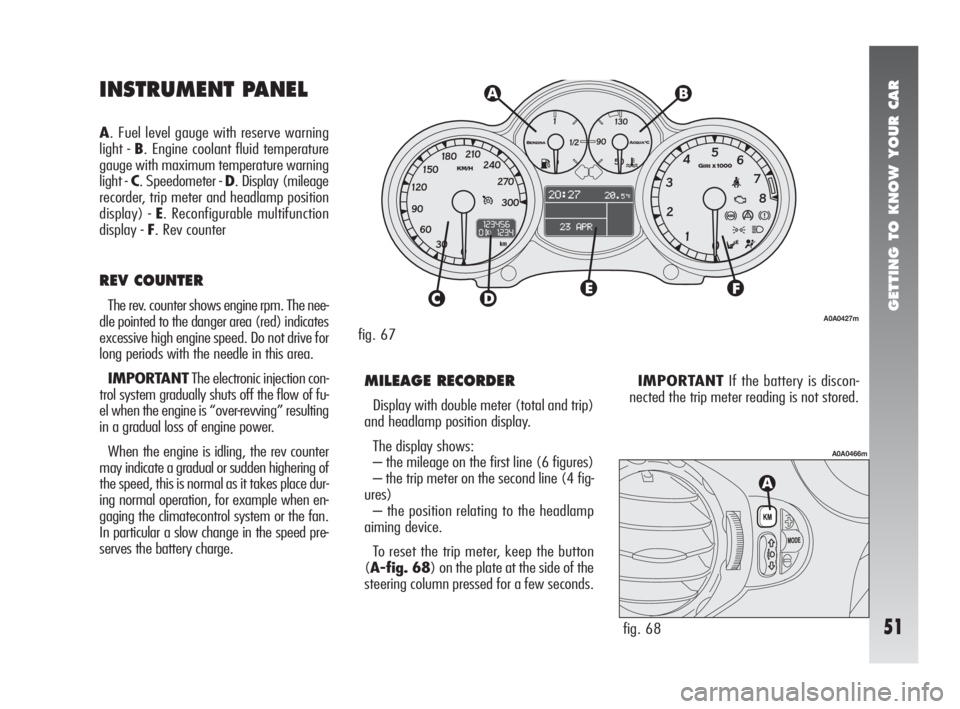
GETTING TO KNOW YOUR CAR
51
MILEAGE RECORDER
Display with double meter (total and trip)
and headlamp position display.
The display shows:
– the mileage on the first line (6 figures)
– the trip meter on the second line (4 fig-
ures)
– the position relating to the headlamp
aiming device.
To reset the trip meter, keep the button
(A-fig. 68) on the plate at the side of the
steering column pressed for a few seconds.IMPORTANTIf the battery is discon-
nected the trip meter reading is not stored. A. Fuel level gauge with reserve warning
light - B. Engine coolant fluid temperature
gauge with maximum temperature warning
light - C. Speedometer - D. Display (mileage
recorder, trip meter and headlamp position
display) - E. Reconfigurable multifunction
display - F. Rev counter
REV COUNTER
The rev. counter shows engine rpm. The nee-
dle pointed to the danger area (red) indicates
excessive high engine speed. Do not drive for
long periods with the needle in this area.
IMPORTANTThe electronic injection con-
trol system gradually shuts off the flow of fu-
el when the engine is “over-revving” resulting
in a gradual loss of engine power.
When the engine is idling, the rev counter
may indicate a gradual or sudden highering of
the speed, this is normal as it takes place dur-
ing normal operation, for example when en-
gaging the climatecontrol system or the fan.
In particular a slow change in the speed pre-
serves the battery charge.
fig. 67
A0A0427m
INSTRUMENT PANEL
fig. 68
A0A0466m
Page 180 of 291
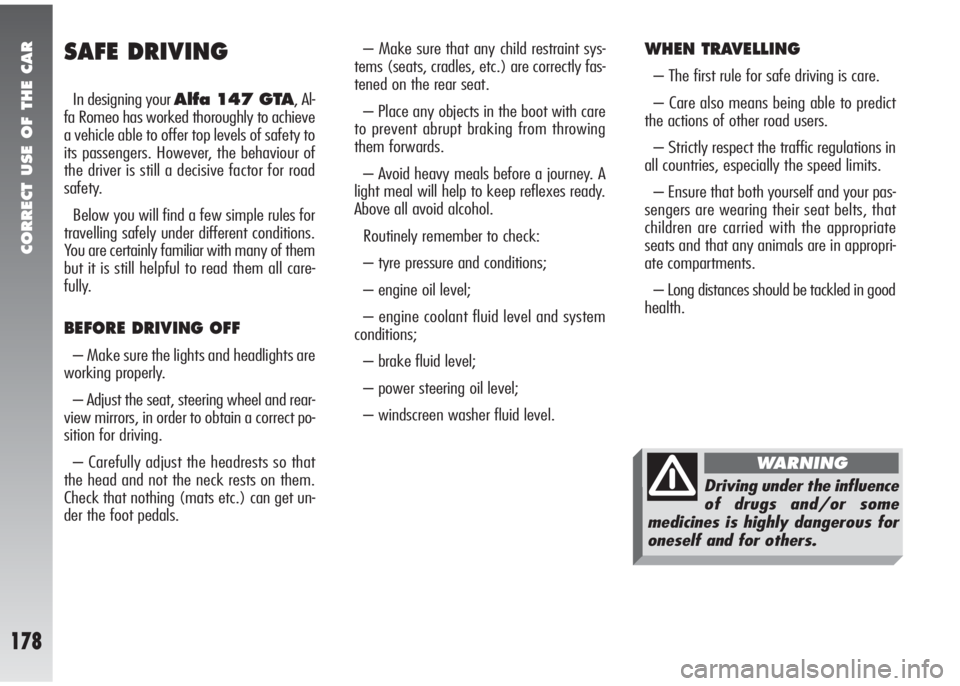
CORRECT USE OF THE CAR
178
SAFE DRIVING
In designing your Alfa 147 GTA, Al-
fa Romeo has worked thoroughly to achieve
a vehicle able to offer top levels of safety to
its passengers. However, the behaviour of
the driver is still a decisive factor for road
safety.
Below you will find a few simple rules for
travelling safely under different conditions.
You are certainly familiar with many of them
but it is still helpful to read them all care-
fully.
BEFORE DRIVING OFF
– Make sure the lights and headlights are
working properly.
– Adjust the seat, steering wheel and rear-
view mirrors, in order to obtain a correct po-
sition for driving.
– Carefully adjust the headrests so that
the head and not the neck rests on them.
Check that nothing (mats etc.) can get un-
der the foot pedals.– Make sure that any child restraint sys-
tems (seats, cradles, etc.) are correctly fas-
tened on the rear seat.
– Place any objects in the boot with care
to prevent abrupt braking from throwing
them forwards.
– Avoid heavy meals before a journey. A
light meal will help to keep reflexes ready.
Above all avoid alcohol.
Routinely remember to check:
– tyre pressure and conditions;
– engine oil level;
– engine coolant fluid level and system
conditions;
– brake fluid level;
– power steering oil level;
– windscreen washer fluid level.
WHEN TRAVELLING
– The first rule for safe driving is care.
– Care also means being able to predict
the actions of other road users.
– Strictly respect the traffic regulations in
all countries, especially the speed limits.
– Ensure that both yourself and your pas-
sengers are wearing their seat belts, that
children are carried with the appropriate
seats and that any animals are in appropri-
ate compartments.
– Long distances should be tackled in good
health.
Driving under the influence
of drugs and/or some
medicines is highly dangerous for
oneself and for others.
WARNING
Page 226 of 291
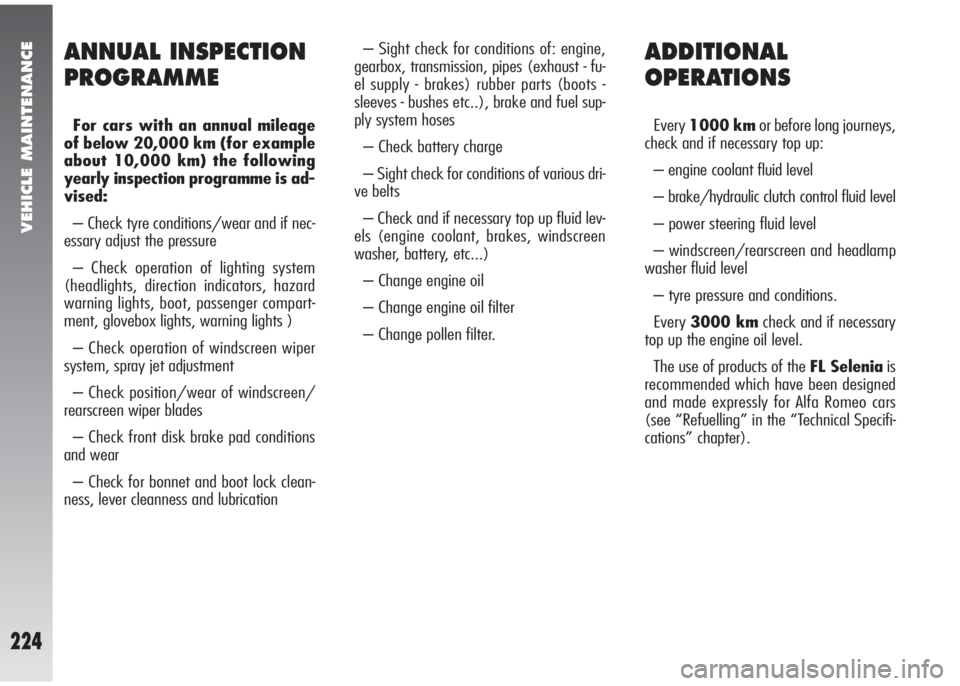
VEHICLE MAINTENANCE
224
ADDITIONAL
OPERATIONS
Every 1000 kmor before long journeys,
check and if necessary top up:
– engine coolant fluid level
– brake/hydraulic clutch control fluid level
– power steering fluid level
– windscreen/rearscreen and headlamp
washer fluid level
– tyre pressure and conditions.
Every 3000 kmcheck and if necessary
top up the engine oil level.
The use of products of the FL Seleniais
recommended which have been designed
and made expressly for Alfa Romeo cars
(see “Refuelling” in the “Technical Specifi-
cations” chapter).
ANNUAL INSPECTION
PROGRAMME
For cars with an annual mileage
of below 20,000 km (for example
about 10,000 km) the following
yearly inspection programme is ad-
vised:
– Check tyre conditions/wear and if nec-
essary adjust the pressure
– Check operation of lighting system
(headlights, direction indicators, hazard
warning lights, boot, passenger compart-
ment, glovebox lights, warning lights )
– Check operation of windscreen wiper
system, spray jet adjustment
– Check position/wear of windscreen/
rearscreen wiper blades
– Check front disk brake pad conditions
and wear
– Check for bonnet and boot lock clean-
ness, lever cleanness and lubrication– Sight check for conditions of: engine,
gearbox, transmission, pipes (exhaust - fu-
el supply - brakes) rubber parts (boots -
sleeves - bushes etc..), brake and fuel sup-
ply system hoses
– Check battery charge
– Sight check for conditions of various dri-
ve belts
– Check and if necessary top up fluid lev-
els (engine coolant, brakes, windscreen
washer, battery, etc...)
– Change engine oil
– Change engine oil filter
– Change pollen filter.
Page 228 of 291
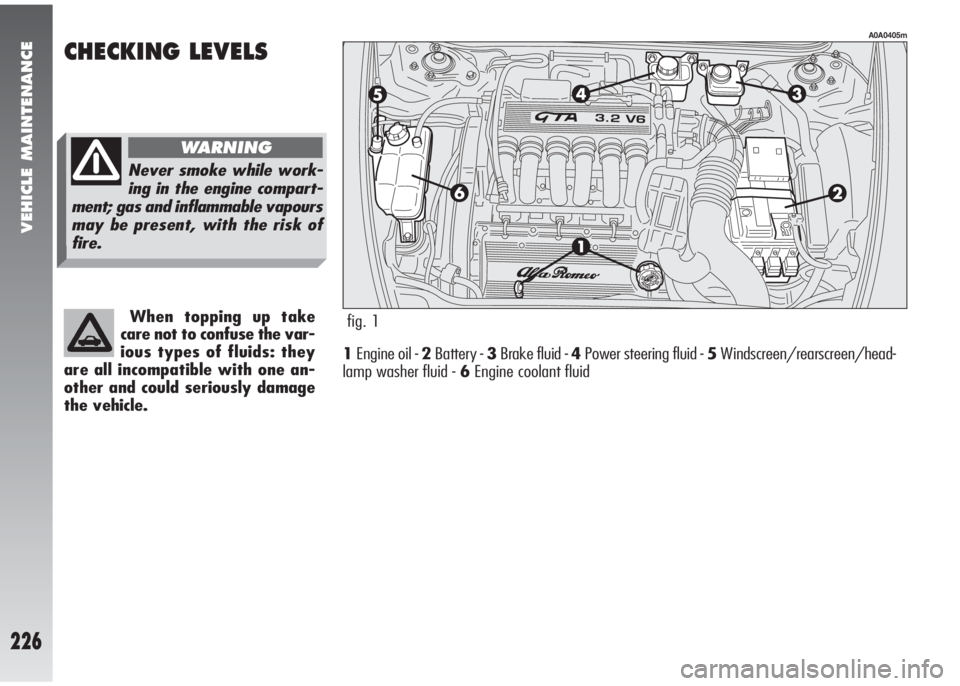
VEHICLE MAINTENANCE
226
A0A0405m
fig. 1
CHECKING LEVELS
1Engine oil - 2Battery - 3Brake fluid - 4Power steering fluid - 5Windscreen/rearscreen/head-
lamp washer fluid - 6Engine coolant fluid When topping up take
care not to confuse the var-
ious types of fluids: they
are all incompatible with one an-
other and could seriously damage
the vehicle.
Never smoke while work-
ing in the engine compart-
ment; gas and inflammable vapours
may be present, with the risk of
fire.
WARNING
Page 231 of 291
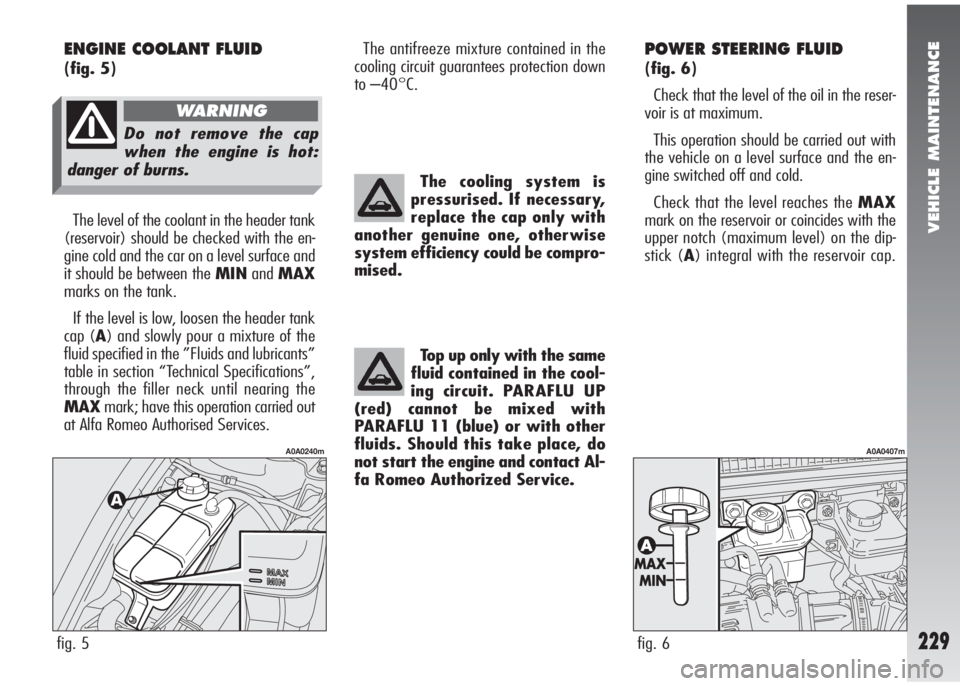
VEHICLE MAINTENANCE
229
POWER STEERING FLUID
(fig. 6)
Check that the level of the oil in the reser-
voir is at maximum.
This operation should be carried out with
the vehicle on a level surface and the en-
gine switched off and cold.
Check that the level reaches the MAX
mark on the reservoir or coincides with the
upper notch (maximum level) on the dip-
stick (A) integral with the reservoir cap. The cooling system is
pressurised. If necessary,
replace the cap only with
another genuine one, otherwise
system efficiency could be compro-
mised.
Top up only with the same
fluid contained in the cool-
ing circuit. PARAFLU UP
(red) cannot be mixed with
PARAFLU 11 (blue) or with other
fluids. Should this take place, do
not start the engine and contact Al-
fa Romeo Authorized Service.
fig. 6
A0A0407m
ENGINE COOLANT FLUID
(fig. 5)
The level of the coolant in the header tank
(reservoir) should be checked with the en-
gine cold and the car on a level surface and
it should be between the MINandMAX
marks on the tank.
If the level is low, loosen the header tank
cap (A) and slowly pour a mixture of the
fluid specified in the ”Fluids and lubricants”
table in section “Technical Specifications”,
through the filler neck until nearing the
MAXmark; have this operation carried out
at Alfa Romeo Authorised Services.
fig. 5
A0A0240m
The antifreeze mixture contained in the
cooling circuit guarantees protection down
to –40°C.
Do not remove the cap
when the engine is hot:
danger of burns.
WARNING
Page 232 of 291
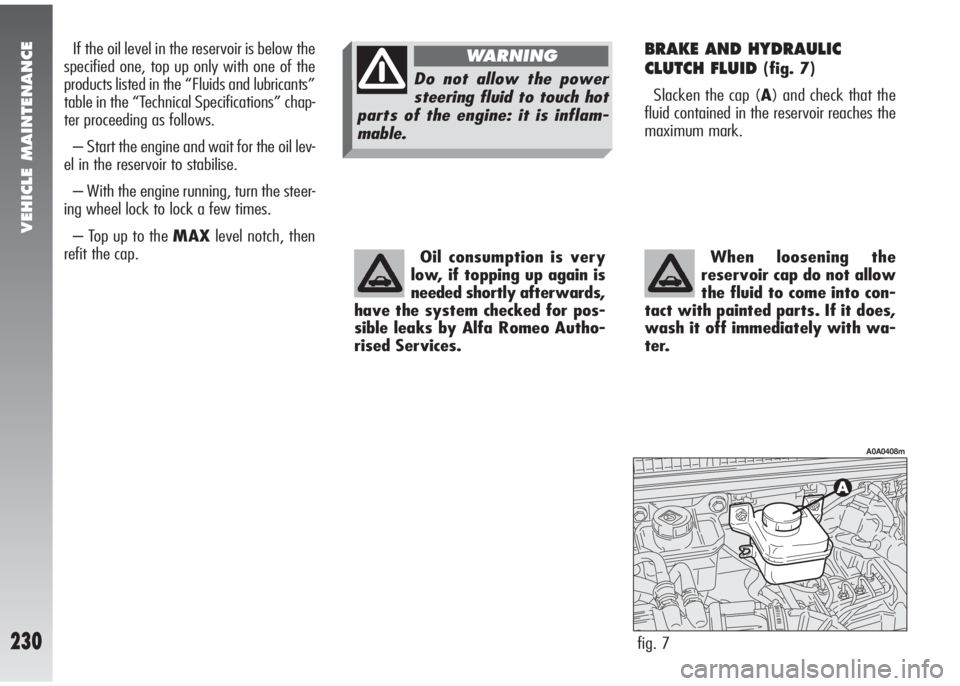
VEHICLE MAINTENANCE
230
If the oil level in the reservoir is below the
specified one, top up only with one of the
products listed in the “Fluids and lubricants”
table in the “Technical Specifications” chap-
ter proceeding as follows.
– Start the engine and wait for the oil lev-
el in the reservoir to stabilise.
– With the engine running, turn the steer-
ing wheel lock to lock a few times.
– Top up to the MAXlevel notch, then
refit the cap.
Oil consumption is very
low, if topping up again is
needed shortly afterwards,
have the system checked for pos-
sible leaks by Alfa Romeo Autho-
rised Services.BRAKE AND HYDRAULIC
CLUTCH FLUID
(fig. 7)
Slacken the cap (A) and check that the
fluid contained in the reservoir reaches the
maximum mark.
fig. 7
A0A0408m
When loosening the
reservoir cap do not allow
the fluid to come into con-
tact with painted parts. If it does,
wash it off immediately with wa-
ter.
Do not allow the power
steering fluid to touch hot
parts of the engine: it is inflam-
mable.
WARNING
Page 249 of 291
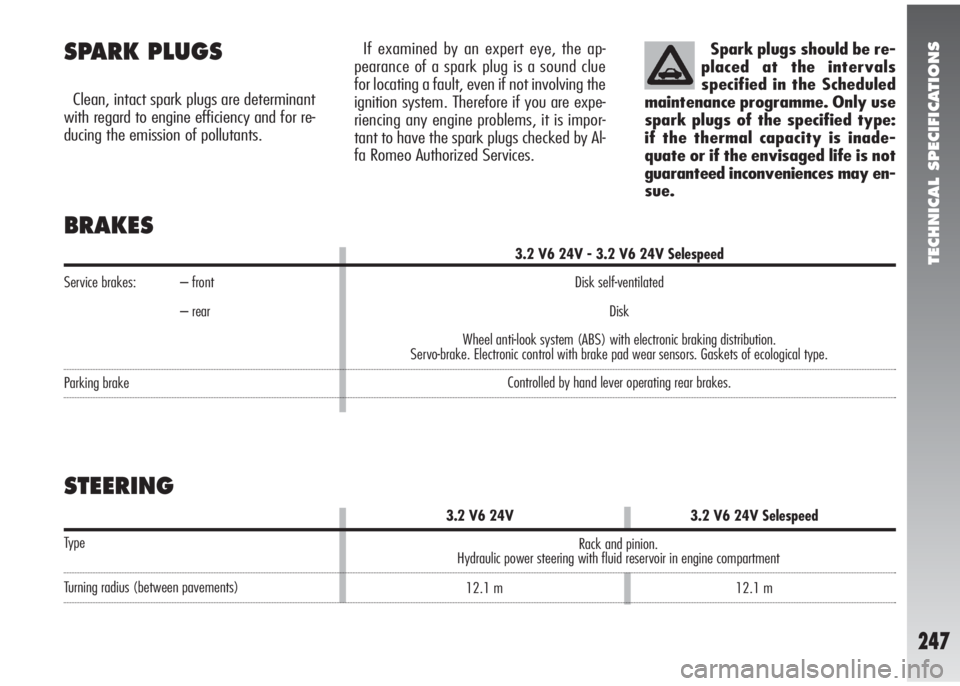
TECHNICAL SPECIFICATIONS
247
SPARK PLUGS
Clean, intact spark plugs are determinant
with regard to engine efficiency and for re-
ducing the emission of pollutants.Spark plugs should be re-
placed at the intervals
specified in the Scheduled
maintenance programme. Only use
spark plugs of the specified type:
if the thermal capacity is inade-
quate or if the envisaged life is not
guaranteed inconveniences may en-
sue.
BRAKES
Service brakes: – front
– rear
Parking brake
If examined by an expert eye, the ap-
pearance of a spark plug is a sound clue
for locating a fault, even if not involving the
ignition system. Therefore if you are expe-
riencing any engine problems, it is impor-
tant to have the spark plugs checked by Al-
fa Romeo Authorized Services.
STEERING
Type
Turning radius (between pavements)
3.2 V6 24V - 3.2 V6 24V Selespeed
Disk self-ventilated
Disk
3.2 V6 24V 3.2 V6 24V Selespeed
Rack and pinion.
Hydraulic power steering with fluid reservoir in engine compartment
12.1 m 12.1 m Wheel anti-look system (ABS) with electronic braking distribution.
Servo-brake. Electronic control with brake pad wear sensors. Gaskets of ecological type.
Controlled by hand lever operating rear brakes.
Page 258 of 291
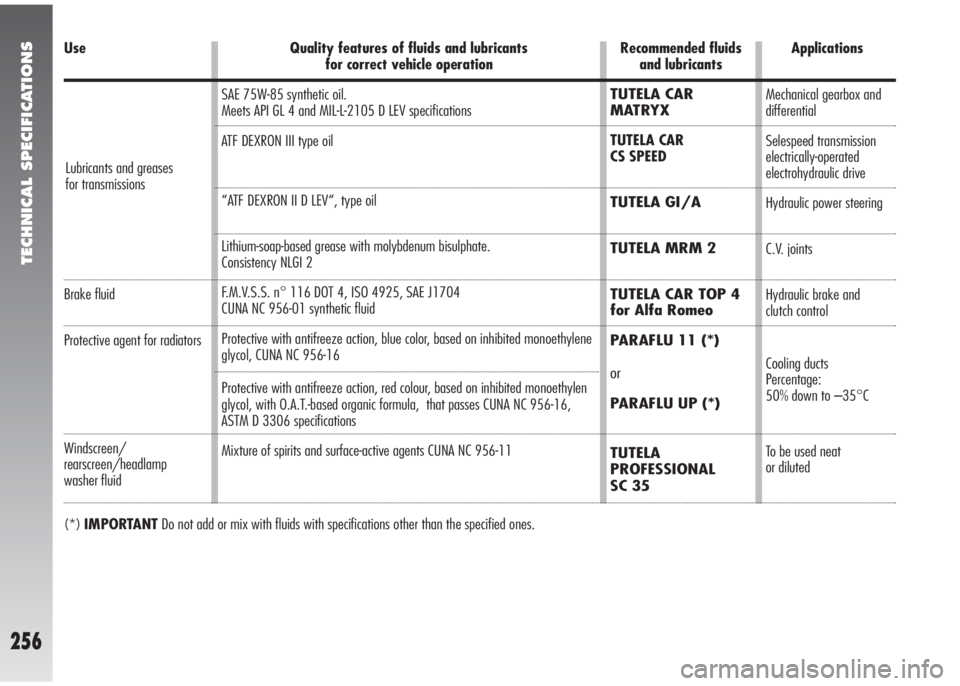
TECHNICAL SPECIFICATIONS
256
Use
Brake fluid
Protective agent for radiators
Windscreen/
rearscreen/headlamp
washer fluid
(*)IMPORTANTDo not add or mix with fluids with specifications other than the specified ones.Recommended fluids
and lubricants
TUTELA CAR
MATRYX
TUTELA CAR
CS SPEED
TUTELA GI/A
TUTELA MRM 2
TUTELA CAR TOP 4
for Alfa Romeo
PARAFLU 11 (*)
or
PARAFLU UP (*)
TUTELA
PROFESSIONAL
SC 35
Applications
Mechanical gearbox and
differential
Selespeed transmission
electrically-operated
electrohydraulic drive
Hydraulic power steering
C.V. joints
Hydraulic brake and
clutch control
Cooling ducts
Percentage:
50% down to –35°C
To be used neat
or diluted Lubricants and greases
for transmissionsQuality features of fluids and lubricants
for correct vehicle operation
SAE 75W-85 synthetic oil.
Meets API GL 4 and MIL-L-2105 D LEV specifications
ATF DEXRON III type oil
“ATF DEXRON II D LEV“, type oil
Lithium-soap-based grease with molybdenum bisulphate.
Consistency NLGI 2
F.M.V.S.S. n° 116 DOT 4, ISO 4925, SAE J1704
CUNA NC 956-01 synthetic fluid
Protective with antifreeze action, blue color, based on inhibited monoethylene
glycol, CUNA NC 956-16
Protective with antifreeze action, red colour, based on inhibited monoethylen
glycol, with O.A.T.-based organic formula, that passes CUNA NC 956-16,
ASTM D 3306 specifications
Mixture of spirits and surface-active agents CUNA NC 956-11
Page 277 of 291

ALPHABETICAL INDEX
275
Brake and clutch hydraulic fluid
- checking level and topping up.... 230
Brakes
- checking fluid level and
topping up .............................. 230
- handbrake .............................. 108
- specifications .......................... 247
Braking lights
- changing bulbs ........................ 205
Bulbs
- general instructions .................. 196
- replacement............................ 198
- types of bulbs ......................... 196
Card holder ................................ 123
Catalyst ...................................... 174
Cell phones (provision) ................. 125
Changing battery of key with
remote control .......................... 10
Changing bulbs- general information.................. 196
- types of bulbs ......................... 196
Checking levels ............................ 226
- checking level and topping
up brake and clutch fluid........... 230
- checking level and topping
up coolant fluid ....................... 229
- checking level and topping
up engine oil ........................... 227
- checking level and topping
up power steering oil................ 229
- checking level and topping up
windscreen/rearscreen/
headlamp washer fluid ............. 231
Children (carrying safely) .............. 31
Cigar lighter ................................ 122
Cleaning and maintenance
- body ...................................... 240
- car interior .............................. 242
- engine compartment ................ 242- leather seats ........................... 242
- plastic parts ............................ 242
- windows ................................ 241
Climate control, automatic
two-zone.................................. 91
Climate control system.............. 89
- air vents ........................ 89-90
- controls .................................. 93
Clock.......................................... 60
Clutch
- checking fluid level and
topping up .............................. 230
CO
2emissions ............................. 258
CODE card................................... 7
Controls ...................................... 106
Correct use of the car............ 175
Courtesy light .............................. 121
- changing bulbs ........................ 207
Cruise control .............................. 47